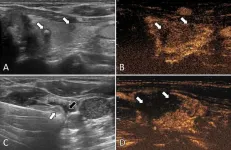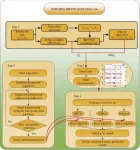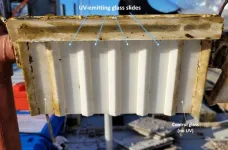(Press-News.org) Cells within the intestines perform various roles including nutrient absorption, sensing, and maintaining homeostasis. Certain chronic disorders are distinctly characterized by gut inflammation, which disrupts intestinal cells and can lead to a remodeling of the gut and the introduction of new immune cells. To better understand the types of cells and their positioning within the intestines, researchers at Brigham and Women’s Hospital, a founding member of the Mass General Brigham healthcare system, in collaboration with investigators at Boston Children’s Hospital, used a new technique known as MERFISH (multiplexed-error robust-fluorescence in situ hybridization) to analyze 940 genes in 1.35 million intestinal cells in a mouse model of colitis. They identified cell populations associated with healthy and inflamed states, mapped their spatial neighborhoods, and traced the evolution of these populations during the inflammation process. One significant cell type to note was fibroblasts, that, when in a distressed state, can induce inflammation associated fibroblasts (IAFs), which may help remodel extracellular matrixes, recruit immune cells, and produce inflammatory cytokines.
However, some key questions still remain, including the specific diversity of IAF populations, their precise tissue locations, and how they emerge during inflammation. Nevertheless, the researchers were able to generate a unique spatial atlas of a mouse colon both in a healthy state, and during intestinal inflammation, which has the potential to assist with therapeutic treatments for chronic inflammatory diseases. In previous studies, IAFs have been observed in a variety of diseases, including cancers and autoimmune diseases, so understanding the role and mechanisms of IAFs may help with the development of treatments for these other diseases.
“Our team wanted to better understand how cells are organized within the gut, and how inflammation can impact cellular interactions and communication at the tissue scale,” said senior author Roni Nowarski, PhD, of the Brigham’s Department of Neurology and Harvard Medical School’s Department of Immunology. “This work is particularly exciting and has given us a better understanding of the tissue context of cellular responses during inflammation, which we hope will help us design better therapeutics to fight serious chronic inflammatory diseases.”
The full article can be read in Cell.
Authorship: Co-authors of the paper include Paolo Cadinu, Kisha N. Sivanathan, Aditya Misra, Rosalind J. Xu,Davide Mangani, Evan Yang, JosephM. Rone, Katherine Tooley, YoonChul Kye, Lloyd Bod, Ludwig Geistlinger, Tyrone Lee, Noriaki Ono, Gang Wang, Liliana Sanmarco, Francisco J. Quintana, Ana C. Anderson, Vijay K. Kuchroo. Co-senior authors are Jeffrey R. Moffitt and Roni Nowarski.
Paper cited: Cadinu, P et al. “Charting the cellular biogeography in colitis reveals fibroblast trajectories and coordinated spatial remodeling”. Cell. DOI: 10.1101/2023.05.08.539701.
END
Gene analysis generates spatial map of intestinal cells and traces their trajectories during gut inflammation
A new study using spatial transcriptomics was able to chart cellular neighborhoods in the healthy and inflamed gut, as well as showcase the key role of fibroblasts in response to inflammation
2024-04-02
ELSE PRESS RELEASES FROM THIS DATE:
Gloom and doom warnings about climate change do not work
2024-04-02
If you want to spread a message about climate change and global warming, you need to adapt the message according to your intended audience and what you want to achieve.
Researchers have now developed an app to help people who want to spread their message on climate issues to ensure they generate the most support possible – be they researchers, politicians, various decision makers or legislators.
Huge survey involving 63 countries
59,000 people participated in surveys as part of the work on creating the app, and Norway was among ...
The 2024 Career Optimism Index® study highlights shift from the great resignation to a great talent stagnation – and how employers can break through
2024-04-02
Today the University of Phoenix Career Institute® released its 2024 Career Optimism Index®, a comprehensive study examining the state of American workers' career trajectories and sentiments about the future of their job and career opportunities. This year's Index, the fourth consecutive year it has been fielded, reveals that workers and employers are facing a critical moment of talent stagnation in the workplace.
More than half (53%) of Americans report feeling easily replaceable in their job position and 64% of workers say their company does not offer opportunities ...
Minimally invasive procedure may spare patients from thyroid surgery
2024-04-02
OAK BROOK, Ill. – In a 10-center study, microwave ablation offered progression free survival rates and fewer complications than surgery in the treatment of a form of thyroid cancer known as papillary thyroid carcinoma (PTC), according to research published today in Radiology, a journal of the Radiological Society of North America (RSNA).
The most common type of thyroid cancer, PTC often presents with multifocality, meaning that two or more bumps or nodules (papillae) are found within the thyroid gland. The occurrence of multifocality within PTC cases is notably frequent, ranging between approximately ...
Noted UCLA neurologist Dr. Rhonda Voskuhl wins 2024 John Dystel Prize for multiple sclerosis research
2024-04-02
[New York, April 2, 2024] – Rhonda Voskuhl, M.D., an internationally recognized neurologist and investigator at the University of California, Los Angeles, is the winner of the 2024 John Dystel Prize for Multiple Sclerosis Research. She is being recognized for her innovative research to understand mechanisms underlying sex differences in multiple sclerosis (MS) and advancing women’s health.
Women are much more susceptible than men to developing MS, an immune-mediated neurological disease. Voskuhl has conducted extensive basic and clinical research ...
Novel vaccine, PfSPZ-LARC2 Vaccine, to prevent malaria infection developed by Seattle Children’s Research Institute and Sanaria ready for human testing
2024-04-02
April 2, 2024 – In a report published on March 21, 2024 in EMBO Molecular Medicine (A replication competent Plasmodium falciparum parasite completely attenuated by dual gene deletion) investigators at Seattle Children’s Research Institute and Sanaria Inc. describe the development of a whole malaria parasite vaccine strain that infects the liver, develops to the late liver stage, and then gets completely stuck and cannot burst out of the liver to cause symptomatic blood infection. The creation of this strain called LARC2 (Late liver-stage Arresting, Replication Competent) was accomplished by deletion of only two parasite genes out of the approximately 5,000 in the ...
A hybrid data driven framework considering feature extraction for battery state of health estimation and remaining useful life prediction
2024-04-02
A paper proposing a hybrid data driven framework considering feature extraction for battery state of health estimation and remaining useful life prediction was published in the journal Green Energy and Intelligent Transportation on 29 March 2024.
VMD is used for completely non-recursive modal variation to deal with signals. The optimal solution of the variational problem is obtained finally by effective decomposition component of the given signal. By iteration, the VMD algorithm can decompose the signals into some intrinsic ...
Press passes available now for NUTRITION 2024 to be held June 29–July 2
2024-04-02
Complimentary press passes are now available for NUTRITION 2024, the annual flagship meeting of the American Society for Nutrition. Join us June 29–July 2 in Chicago for the latest developments in nutrition research, practice and policy.
As the pre-eminent meeting in nutrition science, NUTRITION attracts thousands of scientists, practitioners, policymakers, advocacy leaders and industry professionals each year. Reporters are invited to attend in person to connect with the field’s leaders and learn about exciting scientific ...
UMass Amherst-led team creates biofilm-resistant glass for marine environments
2024-04-02
AMHERST, Mass. – A group of researchers led by University of Massachusetts Amherst engineers have created ultraviolet (UV) rays-emitting glass that can reduce 98% of biofilm from growing on surfaces in underwater environments, as reported in the journal Biofilm.
Biofilm is a slimy layer of various types of microorganisms that grows on wet surfaces. “If you look down your sink and touch the inner side of it—that slimy substance is biofilm,” describes Mariana Lanzarini-Lopes, ...
Heart health declines rapidly after menopause
2024-04-02
A woman’s cardiovascular risk can rise sharply after she goes through menopause, quickly catching up to men of a similar age and health profile, according to new findings presented at the American College of Cardiology’s Annual Scientific Session. Researchers said the study underscores the importance of recognizing and addressing early warning signs of heart disease risk in women as they lose the protective effects of estrogen after menopause.
“This is a unique study cohort of only post-menopausal ...
Majority of people with heart disease consume too much sodium
2024-04-02
Individuals with heart disease stand to gain the most from a low-sodium diet but, on average, consume over twice the recommended daily sodium intake, according to a study being presented at the American College of Cardiology’s Annual Scientific Session.
Sodium is an essential nutrient, but consuming too much can raise blood pressure, which damages blood vessels and forces the heart to work harder. Excess sodium can also cause the body to retain fluid, exacerbating conditions like heart failure. The current U.S. Dietary Guidelines put out by the U.S. Department of Agriculture ...
LAST 30 PRESS RELEASES:
Tracing the quick synthesis of an industrially important catalyst
New software sheds light on cancer’s hidden genetic networks
UT Health San Antonio awarded $3 million in CPRIT grants to bolster cancer research and prevention efforts in South Texas
Third symposium spotlights global challenge of new contaminants in China’s fight against pollution
From straw to soil harmony: International team reveals how biochar supercharges carbon-smart farming
Myeloma: How AI is redrawing the map of cancer care
Manhattan E. Charurat, Ph.D., MHS invested as the Homer and Martha Gudelsky Distinguished Professor in Medicine at the University of Maryland School of Medicine
Insilico Medicine’s Pharma.AI Q4 Winter Launch Recap: Revolutionizing drug discovery with cutting-edge AI innovations, accelerating the path to pharmaceutical superintelligence
Nanoplastics have diet-dependent impacts on digestive system health
Brain neuron death occurs throughout life and increases with age, a natural human protein drug may halt neuron death in Alzheimer’s disease
SPIE and CLP announce the recipients of the 2025 Advanced Photonics Young Innovator Award
Lessons from the Caldor Fire’s Christmas Valley ‘Miracle’
Ant societies rose by trading individual protection for collective power
Research reveals how ancient viral DNA shapes early embryonic development
A molecular gatekeeper that controls protein synthesis
New ‘cloaking device’ concept to shield sensitive tech from magnetic fields
Researchers show impact of mountain building and climate change on alpine biodiversity
Study models the transition from Neanderthals to modern humans in Europe
University of Phoenix College of Doctoral Studies releases white paper on AI-driven skilling to reduce burnout and restore worker autonomy
AIs fail at the game of visual “telephone”
The levers for a sustainable food system
Potential changes in US homelessness by ending federal support for housing first programs
Vulnerability of large language models to prompt injection when providing medical advice
Researchers develop new system for high-energy-density, long-life, multi-electron transfer bromine-based flow batteries
Ending federal support for housing first programs could increase U.S. homelessness by 5% in one year, new JAMA study finds
New research uncovers molecular ‘safety switch’ shielding cancers from immune attack
Bacteria resisting viral infection can still sink carbon to ocean floor
Younger biological age may increase depression risk in older women during COVID-19
Bharat Innovates 2026 National Basecamp Showcases India’s Most Promising Deep-Tech Ventures
Here’s what determines whether your income level rises or falls
[Press-News.org] Gene analysis generates spatial map of intestinal cells and traces their trajectories during gut inflammationA new study using spatial transcriptomics was able to chart cellular neighborhoods in the healthy and inflamed gut, as well as showcase the key role of fibroblasts in response to inflammation




